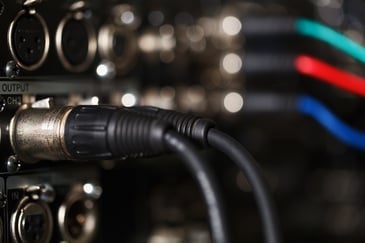(In this blog post, Tripp Lite explains the features HDMI 2.1 brings - and a good overview of the upgrade process. -Teddi)
 HDMI 2.1 is here, and it's faster and bolder than all previous versions, including HDMI 2.0. So, what does that mean? Do you have to upgrade all of your HDMI cables and equipment? Not necessarily. Read on to find out from Tripp Lite why upgrading to HDMI 2.1 cables may or may not be a smart choice for your home theater, business or digital signage application.
HDMI 2.1 is here, and it's faster and bolder than all previous versions, including HDMI 2.0. So, what does that mean? Do you have to upgrade all of your HDMI cables and equipment? Not necessarily. Read on to find out from Tripp Lite why upgrading to HDMI 2.1 cables may or may not be a smart choice for your home theater, business or digital signage application.
The new version of HDMI provides bandwidth up to 48 Gbps, a vast improvement over HDMI 2.0's 18 Gbps bandwidth. This enables you to transmit 5K, 8K or even 10K video resolution with frame rates up to 120 fps (frames per second) with Dynamic HDR (High Dynamic Range). Although no current television broadcasts, streaming sites or home video formats support 10K, some high-end video gaming applications do, especially some graphics-heavy games.
Switching to HDMI 2.1 is actually pretty easy! All you need to do is switch out your old HDMI cables for new HDMI 2.1 cables. The connectors are the same size and shape, and HDMI 2.1 is backward compatible with your current 2.0 or earlier equipment. Even if you haven't yet upgraded your AV equipment or computers to HDMI 2.1, your cables will work with those devices. However, note that most of HDMI 2.1's advanced features won't be available without it.
As mentioned earlier, you can also see some improvements with audio on HDMI 2.1. Your audio receive, amplifier and sound bar will see a strong enhancement with HDMI 2.1's eARC (enhanced Audio Return Channel) feature. Even better than HDMI's ARC feature, eARC allows the installation of advanced audio codecs (like DTS:X and Dolby Atmos) and uses the available increased bandwidth to carry louder, sharper audio signals.
So, circling back to that original question: should you upgrade? While the enhanced 48 Gbps bandwidth and 120 fps refresh rate are exciting, few source or display devices support HDMI 2.1 technology, and the ones that do come with a high price tag. But staying ahead of the curve is good, and the first 8K televisions with HDMI 2.1 support are already on the market, delivering resolutions up to 7680 x 4320 at 60 Hz. As HDMI 2.1-compatible equipment becomes more and more available and affordable, having HDMI 2.1 cabling in place will put you ahead of the game, and HDMI 2.1 cables work with your existing HDMI devices.


.png?width=58&height=58&name=X_logo_2023_(white).png)
